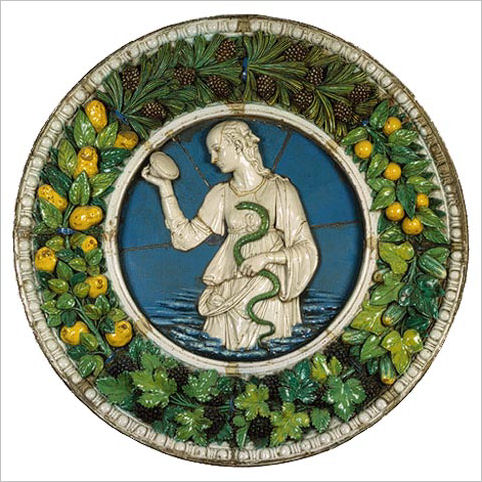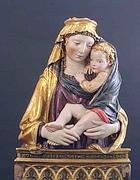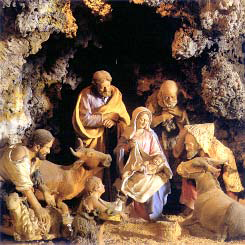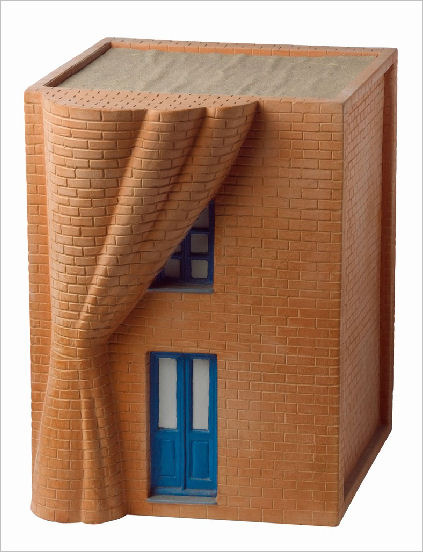 According to Giorgio Vasari (1511-1574), the famous biographer of Renaissance painters, sculptors and architects, Luca della Robbia’s technique was so revolutionary that he’d be praised for it for many centuries to come. He explained how it was not such a hard work to make a clay sculpture and the only reason why clay had not been used much so far was that it could not be preserved over time. Luca, after many experiments, managed to invent a special mixture of minerals. This glaze, used to coat the sculptures before the firing in a suitable kiln, would make them almost eternal.
According to Giorgio Vasari (1511-1574), the famous biographer of Renaissance painters, sculptors and architects, Luca della Robbia’s technique was so revolutionary that he’d be praised for it for many centuries to come. He explained how it was not such a hard work to make a clay sculpture and the only reason why clay had not been used much so far was that it could not be preserved over time. Luca, after many experiments, managed to invent a special mixture of minerals. This glaze, used to coat the sculptures before the firing in a suitable kiln, would make them almost eternal.
Ugo La Pietra Art Ceramics in Castellamonte
March 7 – 30, 2009
Castellamonte – Italy
“Terre e Territori” (Clays and Territories) promises to be an extremely interesting and rich exhibition, gathering more than 200 ceramic works signed by a man (and an artist, a designer, an architect, a great teacher, a journalist, a film director …) who stands out for his contribution to Italian Modern Art.
Since the 60’s he has been exploring the relationship between human beings and their environment and how it affects the evolution of the objects they use, the habits they develop, their perceptions of the space surrounding them, their communication.
Fascinated by visual media, be it new technology or traditional handcraftsmanship, La Pietra has used many of them to carry on his researches on everyday objects, to him useful functional tools, but also symbols of a specific decorative culture.
Pottery making has been part of his artistic evolution since the 80’s, when he started to work on the idea of a positive interaction between industrial design and the rich imagery of Italian ceramic craftsmanship. With very interesting results, indeed.
Pottery in Raphael’s time
April 11-12-13, 2009
Urbania – Italy
An educational talk and guided tour will focus on the close relationship between Renaissance art in Urbino and Casteldurante pottery.
During the Renaissance the Duchy of Urbino, whom Casteldurante (now Urbania) belonged to, was known to be a most fertile background for Arts. The Dukes of Urbino ruled over a rich court, with broad cultural interests, that attracted a variety of artists.
Already well known in the previous centuries for their good quality earthenware production, after 1520 the local potters specialized in the making of istoriato majolica, that was to become a worldwide symbol of Italian Renaissance pottery. They were certainly encouraged by the enlightened attitude of the Dukes from Urbino and inspired by the success of the figurative painters working at Court.
Ceramica del Ferlaro. Italian Pottery Makers since 1937
February 28 – March 8, 2009
Parma, Italy
 In 1913, a young Sicilian noblewoman, Maria Giulia Moncada di Paternò, married the Marquis Giacomo Carrega-Bertolini and moved into his Villa del Ferlaro in Collecchio. She had learned some pottery making techniques in Sicily and she decided to make some pieces for her own pleasure. She was a gifted ceramic artist and her works were very much appreciated by her friends and visitors.
In 1913, a young Sicilian noblewoman, Maria Giulia Moncada di Paternò, married the Marquis Giacomo Carrega-Bertolini and moved into his Villa del Ferlaro in Collecchio. She had learned some pottery making techniques in Sicily and she decided to make some pieces for her own pleasure. She was a gifted ceramic artist and her works were very much appreciated by her friends and visitors.
After the II World War she decided to change her hobby into an entrepreneurial activity. She hired young people from the neighborhood and personally trained them. They soon became the key to success of the newborn Ceramica del Ferlaro.
Maria Giulia’s last work is the “Tahitienne”, made in 1951. She left the management of the company to her son, who contributed to its growth with his open minded attitude towards contemporary art trends. He loved hunting and his passion inspired a successful collection of game pieces.
Famous designers and architects worked with Ceramica del Ferlaro in the Seventies. Their pieces are a valuable part of the historical collection of the company and sought after collectors’ items.
A special exhibition of pottery made by Ceramica del Ferlano from the 30’s to the 70’s will be held in Parma during the Spring edition of Mercante in Fiera, the international trade-fair of modernism, antiques, art and design.
Ceramica del Ferlaro
Fiere di Parma – Mercante in Fiera
Parma
Phone: 0039 0521 9961
Email: info@fierediparma.it
Della Robbia: the Beginners of Italian Architectural Ceramic Art
February 21 – June 7, 2009
Arezzo – Italy
 A sumptuous exhibition in Arezzo, Tuscany, will celebrate the glory of Della Robbia family and it will put into a new perspective the relationship between the Renaissance Majolica and the “major” arts.
A sumptuous exhibition in Arezzo, Tuscany, will celebrate the glory of Della Robbia family and it will put into a new perspective the relationship between the Renaissance Majolica and the “major” arts.
More than 150 Ceramic Art Works from the most important Museums of the world will be on view beginning February 21st at the National Art Museum and additional 180 large pieces will be the key attractions of 5 especially designed itineraries along the Valdarno, Valdichiana and Valtiberina valleys and the Casentino mountains.
For the very first time, Della Robbia’s ceramics will be side by side – in open dialogue, as stated by the curators – with contemporary sculptures, paintings, architectural works and decorative art pieces, such as glass, majolica, porcelain, marble and wood mosaics, prints, etc.
This unusual setting will highlight the innovative content of Della Robbia’s works while delighting the visitors with the poetic genius of Renaissance artists: Donatello, Ghiberti, Andrea del Verrocchio, Rossellino, Pisanello, Filippo Lippi, Pollaiolo, Ghirlandaio, Perugino, Lorenzo di Credi, Leonardo, Fra’ Bartolomeo, Domenico Veneziano, Fra’ Carnevale, Sansovino.
Keep reading our Articles for more info on the works and lives of Della Robbia family.
Museo Statale d’Arte Medievale e Moderna
Via S. Lorentino, 8
Arezzo
Open every day from 9 am to 7 pm
Ph. 800 90 44 47 (toll free) or 0039 049 2010067
Italian Ceramics celebrate Valentine’s Day
Save the date!!!
On February 14th the Museum of Ceramics in Deruta and Montelupo celebrate Lovers and the timeless (and inspired!) connection of Art and Love.
If Deruta is your choice, the rendez-vous is at 4 pm downtown, at the Regional Museum of Ceramics, ready for “Dulce est Amare”, a guided tour to the collection of Renaissance Love Cups that won this tiny village huge fame in the world.
The Love Cups – coppe amatorie, often decorated with beautiful women’s profiles, hearts, joined hands, were awesome Italian majolica wedding gifts very popular among wealthy families. The bride and the groom would both drink from their customized cup on their wedding day and the groom would offer “confetti” (sugar coated almonds) from the Love Cup or Love Dish to all the guests.
If you’re more into Tuscan pottery, the Museum of Ceramics in Montelupo will welcome you with a “buy one ticket get one free” promotion and a sweet chocolate gift from 10 am to 6 pm.
Enjoy!
Lucerna Circus – A Ceramic Oil Lamp Exhibition
February 7-17, 2009
Perugia – Italy
 Each year the Lungarotti Foundation harnesses the creative forces of important Italian artists to offer a new, creative vision of the oil lamp and its flickering light that accompanied the life of people for many centuries. Oil lamps have been used in Italy until the end of World War 1. They were usually made of clay and burned olive oil, that neither smells nor smokes.
Each year the Lungarotti Foundation harnesses the creative forces of important Italian artists to offer a new, creative vision of the oil lamp and its flickering light that accompanied the life of people for many centuries. Oil lamps have been used in Italy until the end of World War 1. They were usually made of clay and burned olive oil, that neither smells nor smokes.
This year the project was assigned to Stelio Zaganelli e Cristina Frezzini, two young designers from Umbria, assisted in the making of their works by the School of Ceramic Art Romano Ranieri in Deruta.
In a brilliantly creative association of ideas, they have jumped from the magic of the olive tree and oil – almost sacred in Italy – to the magic of the Circus.
Inspired by the atmosphere of poetry surrounding the 19th century Circus, so close to human virtues and vices, their large ceramic oil lamps/sculptures represent the key characters of the Lucerna Circus:
Sissi, the slender and elegant dancer, always in the limelight, desperate for a loving soul to share her destiny with;
Filo, the slim funambulist, continuously challenging his records but depending on drugs to keep his pace steady;
New Clays – Languages of the Young Italian Art Pottery
Dec. 19, 2008 – Jan. 30, 2009
Baronissi – Italy
An extraordinary exhibition  has just been opened at the FRAC Baronissi – Regional Fund of Contemporary Art – that will feature the works of a new generation of artists who’ve chosen clay to express their Art.
has just been opened at the FRAC Baronissi – Regional Fund of Contemporary Art – that will feature the works of a new generation of artists who’ve chosen clay to express their Art.
Born in the Seventies and the Eighties, they represent what’s new in the technical and visual language of Italian ceramics. A unique initiative, indeed, since it builds on the differing Italian traditions – Deruta, Savona, Padova, Vietri, Faenza, Lucca, Urbino and Salerno among the others – and techniques, which include a number of experiments with contemporary images and materials.
In his introduction to the event the director of the FRAC Baronissi says that the exhibition features a carefully selected sample of the languages and the practices used in modern Italian ceramic art. These languages preserve the lively cells of the valuable Italian heritage while participating in the contemporary art experiences and blending clay with other materials and creative processes. Italian pottery is therefore a language among other languages, all of them having in common imagination, creativity and a contemporary spirit.
Italian Clay Art: Brunelleschi’s Madonna first time on exhibit
Dec. 15, 2008 – Feb. 28, 2009
Firenze – Italy
 An adorable clay sculpture of the Madonna with Child recently attributed to Filippo Brunelleschi (1377-1446) will be on exhibit for the first time through Feb. 28th, 2009 in the Opificio delle Pietre Dure in Florence.
An adorable clay sculpture of the Madonna with Child recently attributed to Filippo Brunelleschi (1377-1446) will be on exhibit for the first time through Feb. 28th, 2009 in the Opificio delle Pietre Dure in Florence.
The terracotta bust portraits a young woman with downcast eyes, deep in thought. She gently holds her baby, who leans on her shoulder with profound trust and intimacy, interlocking his legs with her arms.
Sicilian pottery – Nativity Scenes from Caltagirone
Caltagirone was  founded as early as the 2nd century B.C. on a steep hill made of clay. The abundance and the good quality of the raw material encouraged the making of pottery and its trade.
founded as early as the 2nd century B.C. on a steep hill made of clay. The abundance and the good quality of the raw material encouraged the making of pottery and its trade.
First the Romans, then the Greeks, the Arabs, the Spanish and the Normans dominated the city, bringing in their traditional designs and techniques which merged into a unique ceramic production and one of the most distinctive Sicilian pottery traditions.
The Nativity figures were certainly part of the local production already during the Middle Age, as reported in many documents, although no actual example has ever been found due to the terrible earthquake that destroyed the city in 1693.
However, it can be argued that no proper artistic production took place before the 18th century. At this time the more talented potters started to make hand modeled freestanding figures that represented not only the key characters in the Nativity crib, but also the local characters in their daily tasks: the cheese maker, the hunter, the shepherd and so on.
The Real world became part of the Sacred world, carrying into the Nativity Scene the ever changing social scenario, the attitude of people, their everyday clothes and even their common gestures.

